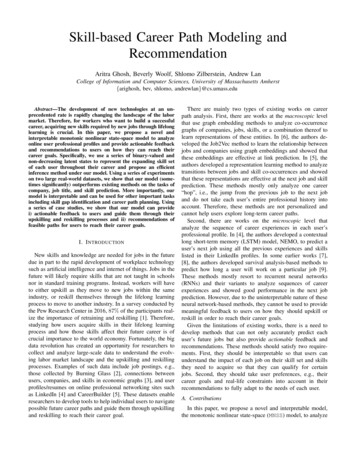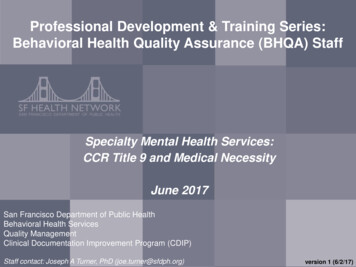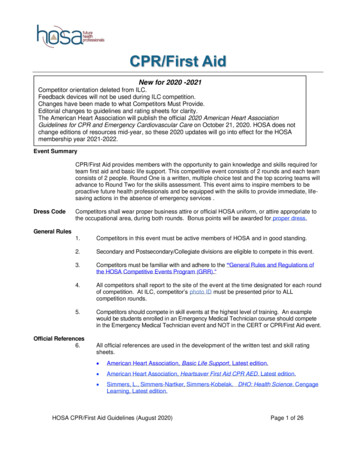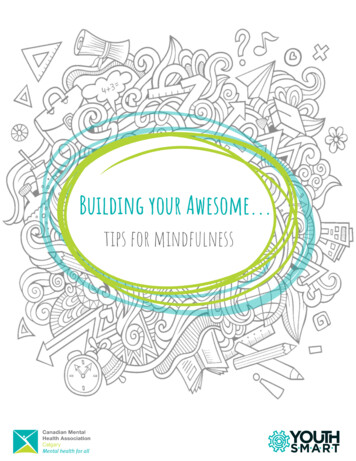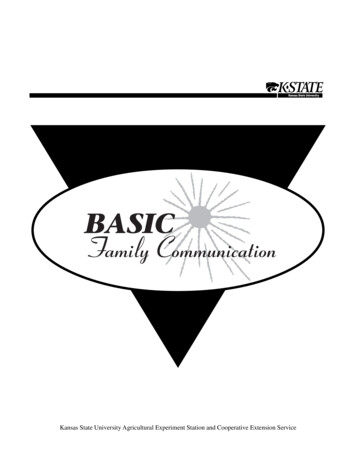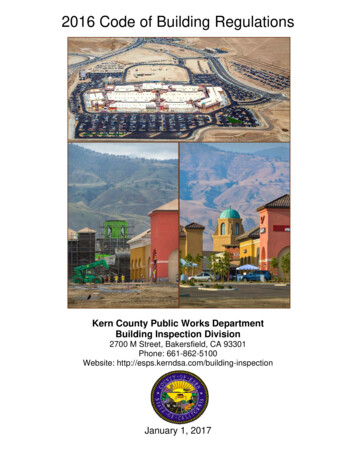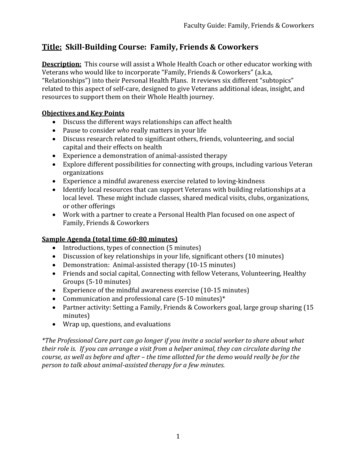
Transcription
Faculty Guide: Family, Friends & CoworkersTitle: Skill-Building Course: Family, Friends & CoworkersDescription: This course will assist a Whole Health Coach or other educator working withVeterans who would like to incorporate “Family, Friends & Coworkers” (a.k.a,“Relationships”) into their Personal Health Plans. It reviews six different “subtopics”related to this aspect of self-care, designed to give Veterans additional ideas, insight, andresources to support them on their Whole Health journey.Objectives and Key Points Discuss the different ways relationships can affect health Pause to consider who really matters in your life Discuss research related to significant others, friends, volunteering, and socialcapital and their effects on health Experience a demonstration of animal-assisted therapy Explore different possibilities for connecting with groups, including various Veteranorganizations Experience a mindful awareness exercise related to loving-kindness Identify local resources that can support Veterans with building relationships at alocal level. These might include classes, shared medical visits, clubs, organizations,or other offerings Work with a partner to create a Personal Health Plan focused on one aspect ofFamily, Friends & CoworkersSample Agenda (total time 60-80 minutes) Introductions, types of connection (5 minutes) Discussion of key relationships in your life, significant others (10 minutes) Demonstration: Animal-assisted therapy (10-15 minutes) Friends and social capital, Connecting with fellow Veterans, Volunteering, HealthyGroups (5-10 minutes) Experience of the mindful awareness exercise (10-15 minutes) Communication and professional care (5-10 minutes)* Partner activity: Setting a Family, Friends & Coworkers goal, large group sharing (15minutes) Wrap up, questions, and evaluations*The Professional Care part can go longer if you invite a social worker to share about whattheir role is. If you can arrange a visit from a helper animal, they can circulate during thecourse, as well as before and after – the time allotted for the demo would really be for theperson to talk about animal-assisted therapy for a few minutes.1
Faculty Guide: Family, Friends & CoworkersPreparation1. Pre-Reading for Instructors Passport to Whole Health, Chapter 10. Family, Friends & Coworkers. Available 3rd-Edition2018.pdf. Pay particular attention to the research findings, so that you can talkmore about them if needed Might help to keep a listing of all your different ideas for “making one small change.” The Whole Health Education Website has a number of additional materials that areworth a look. nds-coworkers/.2. Prepare course materials and handouts This course is best taught in collaboration with a social worker. They can help withthe “Work with a Professional” section. They could also lead the compassionmeditation if you so choose. In addition, you can invite someone who does animalassisted therapy to circulate in the room with a dog or other animal and speakbriefly about what they do Be sure that you have practiced the loving-kindness exercise yourself first. It canhelp to record it and play it back. The more you can share from your ownexperience with this type of meditation, the better Each participant will receive a copy of the Veteran Handout designed to accompanythis course You may also wish to provide some additional Veteran handouts related to Family,Friends & Coworkers, available ndouts/index.asp#family-friends-and-co-workers It may be easiest to have handouts ready for them at their seats, or you can passthem around later. Review the handout in advance, so you can be ready forquestions Be sure to have an evaluation form ready to give them at the end as well. These areprovided with the other course materials Make sure everyone has a pen or pencil and blank paper for the writing exercise3. Set up AV and other equipment Be prepared to share the PowerPoint slides related to this course. A guide to each ofthe individual slides is featured later in this document Connect with the AV support person at your site A flip chart and markers, or a dry erase board, may be helpful If you choose to show the video, will need to attach speakers to the computerrunning your PowerPoint presentation If you do not have a slide projector, you can simply take them through the Veteranhandout after you give each person a copy. Alternatively, you can print out theslides and give them copies. Then, just take them through the slides, following thefaculty guide2
Faculty Guide: Family, Friends & Coworkers4. Identify local and other resources This is a great opportunity to invite one in a social worker, as noted above. Bemindful of time constraints Add to the slide set (and/or Veteran Handout) to include local resources, includingo Classes, group visits, and group therapy sessions available locallyo Any other resources you want to share (be careful about time)3
Faculty Guide: Family, Friends & CoworkersSlide-By-Slide Guide Whole Health Skill-Building:Family, Friends, & Coworkers Name ofInstructor(s) DateLocationPhoto: https://www.va.gov/vetdata/veteran population.asp Let’s Discuss: Connections Replace “I” with“We” and illnessbecomes wellness.-Satchitinanda2 The Central Question 3Change this slide to incorporate your name, as well asthe date and location of the presentationThis is a good time to introduce yourself. Be sure toshare your own title/role related to the VA andteachingIt is worth it to have the participants do quickintroductions as well, but be mindful of timeMany of the self-care topics focus us inward. For thisone, we will focus outward, on relationships and thepower of connection and relationshipThis is the list of learning objectives for the course.You can review these in detail, or go quickly overthem to save timeAs you move through, remember the subtitle for thiscircle is “Relationships.” There are many ways tothink about our relationships in our livesThe main message here is that Whole Health caninclude any of the ways we connect with others,because they are all closely tied to our healthStart by discussing as a large group. What does itmean to connect with someone?What are some examples of connections? They shouldcome up with significant others (be careful aboutgender for couples, and don’t assume they aremarried), family (your birth family, or your chosenfamily), friends, pets, colleagues, fellow Veterans,groups, and organizations (churches, classes, interestgroups). When people served, their duty stationsforced them to build relationships – some healthy,some notWe’ll talk to some degree about each of theseReally emphasize that we are expanding from askingthe usual mission/aspiration/purpose (MAP)question – What really matters - to also ask “Whoreally matters?”Often, when people are asked about what reallymatters to them, other people come up. They want tosee their grandkids grow up, spend time with friends,etc.Encourage them to think about their answers to thisquestion – it will come up again later4
Faculty Guide: Family, Friends & CoworkersZeroing in on OptionsMake OneSmall ChangeWork withan ExpertConnect withLoved OnesFamily, Friends& CoworkersRelationshipsPracticeCompassion Connect withOtherVeterans andCommunityImproveCommunication Make OneSmall ChangeWork withan ExpertConnect withLoved OnesFamily, Friends& CoworkersRelationshipsPracticeCompassionHere is a list of areas we will discuss in more detail,going clockwise. Think of this as looking at circleswithin the circle, when it comes to relationshipsRead each of the circles, to introduce themThese are simply suggestions related to what can beincluded in a Personal Health Plan Connect withOtherVeterans andCommunityConnecting with loved ones is something where noone really questions its importance. That doesn’tmake it easy. In fact, it can be really tough sometimesAs you talk about this topic, remind them that there islots of space for who a ‘loved one’ can be in your life –pets, friends, partners, kids, etc.ImproveCommunication Have them reflect on these questions, THEN pair upafter they have had time to think for a minute or twoIt might be helpful to have pens/pencils available sothey can write things downLet them know it is normal for this exercise to bringup some feelingsThese are findings from two studies featured in thePassportThe first one involved 1400 men and women.Survival 5 years after the heart procedure was 3 timeshigher if they had supportThe second study was older and included 10,000married men talking about their wives. The groupwho said their wives showed their love had 50% lesschest pain and 50% fewer ulcers tooOne other study, not featured, that you can mention ifyou want: Women who were given shocks duringMRI had fewer signs of stress in their brains if theyheld hands with a supportive partner (IF they ratedtheir marriages as good)5
Faculty Guide: Family, Friends & Coworkers Take a survey (last bullet point) of who has animals intheir lives This is an opportunity to have a visit from a therapydog or other therapy/companion animalYou may have already done this in the Surroundingscourse – if so, you can simply omit it (or do it again) Another Question Are there any relationships you wouldlike to heal? 11“Confide” in many studies means being able to talkwith others about something very personal, like yourhealth problems and your emotional concerns aboutthose problemsThere are other types of confiding as wellIt seems to matter how deep your connections go, notjust how many you have. That is, it helps to have onegood friend versus many acquaintances – though it isgreat to have bothStudies show that social media may help somePreface this question by saying you don’t expect themto answer it out loud – just reflectNew relationships can be built, as part of a PersonalHealth Plan. And, past relationships can also berepaired. One goal you can set is to at least reach outto someone to see where things standFor many Veterans – for people in general – reachingout can be tough to do. Ask yourself why that is?Where is the fear coming from? Is reaching out worththe risk of being turned away?6
Faculty Guide: Family, Friends & Coworkers Make OneSmall ChangeWork withan Expert And we can take connection to the next level –connecting not only with individuals but with groups Take just a moment to remind them that the outercircle is all about how we fit into the broadercommunity, which is also important to health. Wedon’t have a healthy “Me” without a healthy “We.” Who are some of the most helpful and supportivepeople for Veterans? Answer: Other Veterans!How can they support their fellow Veterans?Encourage a brief large group discussion about bestways to connect with other VeteransConnect withLoved OnesFamily, Friends& CoworkersRelationshipsPracticeCompassionSocial capital is an idea that was introduced byPutnam in his book, Bowling Alone: The Collapse andRevival of American CommunityIt can help to explore what you have in common withpeople – more in common means more connectionand more social capitalWhat are ways to enhance this capital? Answer:Usually you get more back if you give moreConnect withOtherVeterans andCommunityImproveCommunicationCommunity is Part of the Circle 7
Faculty Guide: Family, Friends & CoworkersGiving: Volunteering and MoreVeterans love working withother Veterans!People who volunteer. Get to help othersLive longerFeel a ‘helper’s high’Feel more of a sense ofaccomplishment Seem to do better with chronicillnesses Find it helps with depression Have lower heart disease risk Photo rt-veterans-during-national-volunteer-week/Even if you can’t volunteer,you can do random acts ofkindness Make OneSmall ChangeWork withan ExpertConnect withLoved OnesFamily, Friends& CoworkersRelationshipsPracticeCompassionConnect withOtherVeterans andCommunityImproveCommunication This is featured in the Personal Developmentmaterials, but it also relates hereAcknowledge that many Veterans “volunteered” to bein the military and serve their country. This may be aloaded term for some. Be ready to emphasize that weare focusing on the more positive aspects of the wordhere, especially around volunteering for fellowVeterans. Volunteering now can help a person bemore of an asset to others who need guidance or helpwith getting on a better courseIn addition to Veteran groups, what other groups doyou belong to? (Can continue the discussion form theprevious slide.)One example of a group is a group of colleagues atworkPoint out that about 10% of the population is veryintroverted – they may not feel as comfortableseeking out groupsThat is okay, but perhaps some of the ways listed herecan be helpfulCommunication can be a challenge for many peoplePeople who have experienced life in the Armed Forceslearn different ways to communicate – followingorders and rapid communication can save your lifeIt can be hard to come back and re-assimilateo E.g., having a non-Veteran bosso Having people not get what it is like to be aVeteran and asking the wrong questionsThe next slides cover a few skills that can help anyonecommunicate better. To learn more, a person cantake a class or work with someone one-on-oneThese might seem basic, but many people don’t dothemThere is an old saying that we have 2 ears and 1mouth, and that tells us how much we should listenversus talkThis is a place where you can summarize some of thetechniques taught in Whole Health Coaching –generous listening, reflection, paraphrasing“I” statements definitely take us all some practice tolearn8
Faculty Guide: Family, Friends & CoworkersMore points about communication: For your health plan, you could practice any one ofthese Some are more relevant for certain types ofconversation. For example, with health care visits, itcan really help to be clear about your goals A huge proportion of communication isn’t the wordsso much as body languageMake OneSmall ChangeWork withan ExpertCan ask, “What does compassion mean to you?” anddiscuss as a large group When they first started doing brain scans to studymeditation, the long-time meditators they studied(Buddhist monks) laughed, because they said the scanshould really focus on the heart, not the headHow does one open one’s heart?Compassion involves empathy – understanding whatit is like to be in someone else’s shoes, combined withtaking action to do something to support them (whichis different from talking about ‘fixing’ the problem)Connect withLoved OnesFamily, Friends& CoworkersRelationshipsPracticeCompassion Connect withOtherVeterans andCommunityImproveCommunication Connection – VA Video Optional to show this video. The key here is to pauseand think, when we communicate, that everyone has aback story going onA big piece of relating to others is tied in withempathy and compassion. They are not the same aspity, and they don’t require you to plunge into theother person’s negative emotional state. It is aboutacknowledging their pain and being present for them9
Faculty Guide: Family, Friends & Coworkers Mindful Awareness:Loving-KindnessPhoto: pickthebrain.com There are many waysmindful awarenesscan tie in torelationships This exercise asks youto focus outward aswell as inward What do you notice? Can do this as a large discussion too, if needed, basedon time. Again, the video is optionalThis discussion will take some time to do effectivelyCan ask about how they do with self-compassion aswell. Can you be driven, or push yourself, and still becompassionate toward yourself?There are many practices intended to buildcompassion toward others. There is also one inchapter 10 of the Passport to Whole Health This is aparticularly important one to have a debrief aboutRead the script that is provided with the coursematerials25 Make OneSmall ChangeWork withan ExpertConnect withLoved OnesFamily, Friends& CoworkersRelationshipsPracticeCompassionConnect withOtherVeterans andCommunity The VA does a really good job thinking beyond aperson’s physical health needs to what they needsocially too – coverage for services, getting intodifferent programs, housing, etc.There are many professionals who can help, and youshould know who they are. Generate a list you canshareImproveCommunication If possible, can be good to have a social workerpresent in the class to share what they doThere are more links about social workers and whatthey can offer in the course handoutsMental health professionals can help with many ofthese as well.The primary care team can help as well.If intense emotions come up while someone isworking with relationships, they should ask for helpas needed.10
Faculty Guide: Family, Friends & CoworkersMake OneSmall ChangeWork withan ExpertAnd our final circle. You can either read all of these, or just let them readthem as you highlight a few of your favoritesAsk them if they have other thoughts, beyond thoselist or other things we have talked aboutConnect withLoved OnesFamily, Friends& CoworkersRelationshipsPracticeCompassion Connect withOtherVeterans andCommunityImproveCommunication The temptation is always to spend more time onlecture and less on experiential activities or skillbuilding. Give this last exercise at least 15 minutesSome people may be hesitant, but encourage them towork with someone else if at all possible. If not, theycan still set a goal on their own, and you can check inwith them while others are working in pairsIf there are an odd number of people, you can alwaysjump into the mix and pair with someone yourselfBe sure to set a timer to remind them to switch who isdoing the talking/planning after half the time haspassedTake time for a large group discussion, and invitepeople to share*Be sure to focus on accountability – how can theycheck in with their partner (text, coffee, email, etc.)?When? Can you as the instructor check in with themat some point? Be sure to talk about their next stepswith all of this work11
Faculty Guide: Family, Friends & Coworkers Setting GoalsSeven steps in goal setting1. Identify the goal2. Know the benefits3. Know obstacles4. List skills and knowledgeneeded5. Identify who can help6. Develop a plan (SMART)7. Set a timeline and nextsteps SMART Goals Specific Measurable Action-based Realistic Time-bound You can leave this slide up while they are talking totheir partner. It can help them create stronger goalsIt doesn’t have to be a complicated process, though.They can choose which of these steps they wish tothink about, and whenIt is up to you if you want to read through the itemson this slide or simply have them read to themselves32Thanks! Feel free to modify this based on which points youchose to emphasize As you finish, be sure to leave time for questions andcomments Photo: vahomeloangure.com3212
Title: Skill-Building Course: Family, Friends & Coworkers Description: This course will assist a Whole Health Coach or other educator working with Veterans who would like to incorporate "Family, Friends & Coworkers" (a.k.a, "Relationships") into their Personal Health Plans. It reviews six different "subtopics"
